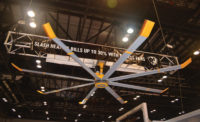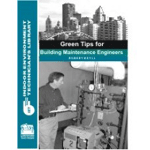Public awareness is growing about the importance of indoor air quality (IAQ) in commercial buildings and homes. That new interest is one of the driving factors behind steadily increasing sales of IAQ products. In fact, the U.S. IAQ market totaled $7.8 billion in 2015. The market should total $10.8 billion by 2021, increasing at a compound annual growth rate (CAGR) of 5.3 percent from 2016 to 2021, according to a Research and Markets report.
ACR Supply Co. in Durham, North Carolina, sells tens of thousands of air filters a month in the commercial market, says Troy Meachum, president.
“Air filtration is a big part of what we do,” he says. “Everybody’s trying to get the cleanest air they can for the best price without any air restrictions.”
Though IAQ products are a growing trend, Meachum says sales very much depend on the economy. “Typically, most places try to change filters out on a quarterly basis. However, when budgets are tight and the economy is not doing as well, they let the filters go a little bit longer, which is not a good practice, but it happens. When the economy is strong, we definitely see more activity in this area. When things get tight, air quality and air filtration seem to go by the wayside, they’re not as urgent or as important.”
Cost Matters
According to the U.S. Environmental Protection Agency (EPA), the growing proliferation of chemical pollutants in consumer and commercial products, the tendency toward tighter building envelopes and reduced ventilation to save energy, and pressures to defer maintenance and other building services to reduce costs have fostered IAQ problems in many buildings. As a result, more building occupants are complaining of odors, stale and stuffy air, and symptoms of illness or discomfort.
More and more building owners and managers are becoming sensitive to problems caused by IAQ, according to Kevin Parsley, vice president and sales director at ACR Supply.
“Commercial building owners are seeing IAQ as a need rather than a premium product,” he says. “Whether or not they are willing to spend the money is another question. They are reluctant sometimes to invest those monies once they finally see the price, unless it’s a need driven by code changes.”
According to Parsley, code changes are another driving factor in the IAQ market. “We are seeing more and more questions regarding CO2 and ventilation. Most of those are code-driven. Additionally, we’re getting more inquiries about VRF [variable refrigerant flow] because you have to have some kind of allocation for outside air, which is driving a lot of movement toward ERVs [energy recovery ventilators].”
People want not only clean air but sanitized surfaces as well, according to Jeff Bennert, co-founder and COO of Air-Oasis LLC.
“The trends in the commercial market have leaned away from ozone-producing units,” Bennert says. "PM 2.5 (particulate matter smaller than 2.5 microns) is a growing concern globally. People are starting to realize that indoor air quality is crucial to good health. There are many people out there who are very sick with a variety symptoms -- everything from asthma to allergic reactions, and their symptoms can be traced back the contamination inside their own homes or place of business. Consumers do not want technologies that will create more toxins; they’re looking for technologies to clean the air and sanitize surfaces – supporting a toxin-free environment. And that’s the trend and the future of IAQ.
Meeting Consumer Expectations
According to Bennert, the residential market is looking for the same thing as the commercial market. “Both seek products to clean the air and surfaces inside the home as well as the ductwork. The ducts and coils are breeding grounds for bacteria and mold, They continually re-expose the home with each cycle. The industry is now recognizing the need to purify what’s coming out of the ductwork as well. In the past, UV lights were sold as whole-home air purifiers, but we know they are only effective at treating surfaces they shine on directly, within inches, and are not whole-home air purifiers. UV lights are ineffective at cleaning air passing at high airflow rates. Consumers want the complete package – something to keep the entire HVAC system cleaner, and most importantly, to clean the ambient air in the home and sanitize surfaces. That technology is offered today by some manufacturers.”
The residential market is driven by a mix of consumer expectations and stricter residential new construction building codes, according to Mike Rimrodt, marketing director for Aprilaire.
“On the consumer side, the growing demand for health and wellness is also driving healthy home trends in the IAQ industry,” Rimrodt says. “Consumers are very concerned about the origin of the food they eat, the purity of the water they drink, and the quality of the air they breathe. They have a greater understanding now more than ever about how IAQ impacts individual health and wellness.”
Rimrodt noted that technology is playing an increasingly important role in how consumers manage their health.
“Wearable tech like Fitbits measure exercise, heart rate and help track cardiovascular health,” he says. “Other smart devices on the market track and improve sleep, measure blood pressure and help reduce stress. Wi-Fi control of IAQ provides consumers with yet another way to control their health with technology by monitoring and managing the conditions in their home. Through Wi-Fi thermostats with IAQ control, HVAC contractors can offer homeowners a solution that further helps connect the dots between technology and personal health. Consumers also value the increased peace of mind of having the status of their home in their pocket, as well as the energy savings that come with simpler scheduling and control versus a traditional programmable thermostat.”
Building codes are also driving the increasing awareness of IAQ.
“Energy-efficient homes conserve money by reducing the amount of air lost to home leakage,” Rimrodt says. “The side effect of this is a build-up of stale indoor air – which leads to humidity and air quality issues in the living space of the home.” This is also leading to a wider range of ventilation products to meet the specific needs that arise in different climate zones. “RNC contractors are certainly placing a high value on IAQ because meeting guidelines for ventilation is a requirement,” he continues. “They need products that meet or exceed ASHRAE 62.2 standards while satisfying a list of other building codes for fresh air and energy efficiency.
“We recently performed a case study with a large national home builder who needed a specific ventilation solution for the mild but humid shoulder seasons on the southern U.S. coast. They have since standardized on our Model 8191 Ventilator with Dehumidification, which removes moisture from outdoor air before delivering it to the living space. It also utilizes air conditioner runtime and temperature lockouts to condition the air as energy-efficiently as possible. Builders are responsive to consumers' needs and desires as well. As IAQ awareness grows, consumers expect homes to have quality air just as they expect clean water.”
Kevin Graebel, global residential health and awareness director for Honeywell Intl. Inc., says there’s a lot of activity happening in the do-it-yourself (DIY) space in the residential market.
“Many consumers are focused on the wellness of their family,” Graebel says. “Products ranging from cameras to sleep monitors promise to monitor your environment to help give you peace of mind in your own home. When you know, your kids are home safe and you haven’t left your window ajar, it also helps you sleep a little better knowing that your humidity levels are in line and your CO2 levels are low. An air quality monitor could alert a parent that the humidity level in their child’s room is too low, but only a whole home steam humidifier can ensure that their whole home consistently meets their desired set points. A baby camera might warn of high CO2 levels in the space, but a whole home ventilation solution can help prevent that from happening. All of these situations can be handled by an HVAC professional.”
Graebel says that while consumers are willing to do more themselves now with the rise of DIY tutorials from sites like YouTube, they still shudder at the idea of working with sheet metal or doing plumbing. “Contractors should be positioning themselves as experts at solving problems and improving the comfort of their living space at the same time, and how they can provide whole-home solutions that are more efficient and consistent in improving comfort.”
Looking Ahead
According to a report from Transparency Market Research, the global air purification systems market was valued at $12.06 billion in 2015 and is projected to reach $24.83 billion by 2024 at a compound annual growth rate (CAGR) of 8.4 percent from 2016 to 2024.
That being says, IAQ is still a relatively new trend, Bennert noted. "Most of what has been considered an air purifier or cleaner in the past is simply a filter and a fan for large particulates. It is important to understand what is available today for improving IAQ: by preventing the build-up of biotoxins and VOCs. There are numerous pollutants we’re exposed to everyday in the home or place of business other than just dust. These pollutants create health issues and should be dealt with to properly solve the IAQ problem. Doing that in a safe, cost-effective way is very important. In the HVAC industry, of course, cost is always an issue.”
Bennert also says that his company has mostly done add-on work.
"It should be more of an issue with new construction because new buildings have higher VOC levels off-gassing from building materials and new furnishings," he said. "There is often more toxic exposure in those first two years than at any other time. We observe more commercial builders addressing IAQ than in the past. Unfortunately, we do not see many home builders offering IAQ products, even as an optional add-on for homebuyers to consider. If one may upgrade their tile or countertops, why not the quality of the air they breathe?"
Meanwhile, the growing awareness of IAQ will continue to rise.
“Significant consumer trends in technology and health and wellness are increasing consumers’ desire to monitor and control IAQ,” Rimrodt says. “That, along with common health issues associated with respiratory health will drive growth in the next five years. It’s difficult to quantify, but the trajectory is positive.”
Comfort controls will continue to become more sophisticated, Graebel adds. “The Honeywell Lyric thermostat has ‘Intelligent comfort control,’ which means it considers both temperature and humidity so that 72 degrees always feels like 72 degrees. As more components continue to get linked together, more of these types of smart integrations will happen.”













